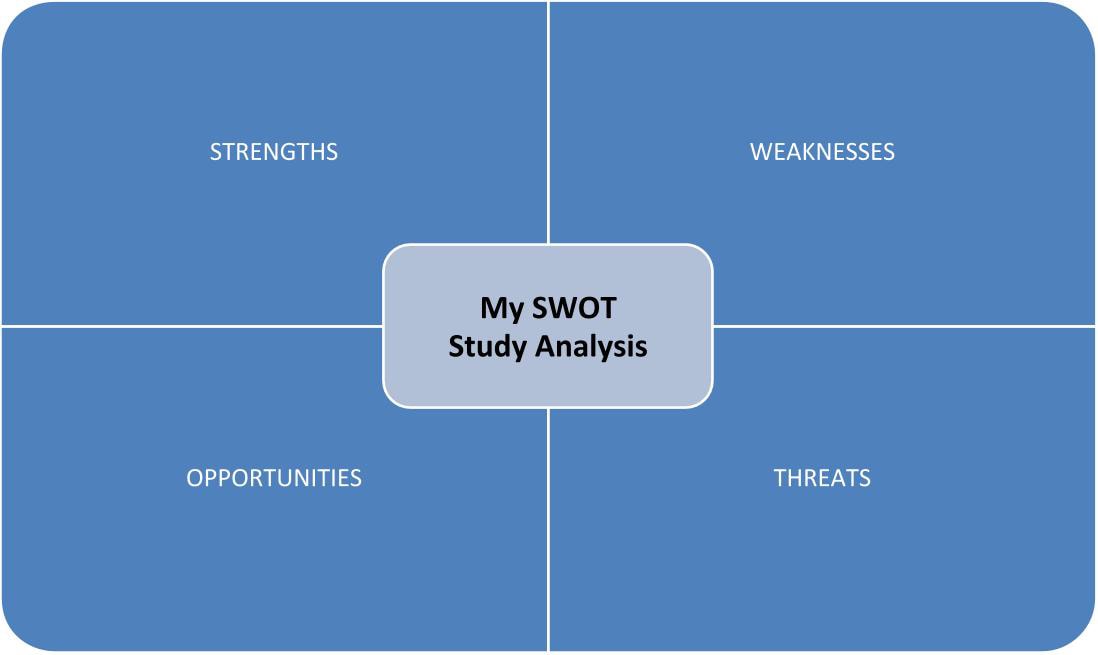Students investigate their strengths and goals to reflect on their study routines.

Year level
9-12

Duration
60 minutes

Type
In class activity
Online learning

SEL Competencies
Self-awareness
Self-management
Learning intention
Students assess their study habits through a SWOT analysis.
Key outcomes
By the end of the lesson, students will be able to:
understand their own strengths, weaknesses, and threats and opportunities
appreciate how managing their time can impact their levels of stress.
Materials needed
Student access to the ReachOut.com article '5 steps to study success'
Student access to the ReachOut.com article 'Stress swaps'
Student access to the ReachOut.com article 'How to manage your time while studying'
Student access to the ReachOut.com article 'How to nail your study-life balance'
Mapped to
Australian Curriculum: Health and Physical Education
Plan, rehearse and evaluate strategies for managing situations where their own or others’ health, safety or wellbeing may be at risk (AC9HP10P08)
Evaluate emotional responses in different situations to refine strategies for managing emotions (AC9HP10P06)
Australian Curriculum: General Capabilities
Personal and Social Capability:
Self-awareness
Self-management
Critical and Creative Thinking:
Reflecting
Inquiring
NSW PDHPE Syllabus
Assesses their own and others’ capacity to reflect on and respond positively to challenges (PD5-1)
Critiques contextual factors, attitudes and behaviours to effectively promote health, safety, wellbeing and participation in physical activity (PD5-6)
Assesses and applies self-management skills to effectively manage complex situations (PD5-9)
Victorian Curriculum: Health and Physical Education
Evaluate situations and propose appropriate emotional responses, and then reflect on possible outcomes of different responses to health and wellbeing (VCHPEP147)
Activity 1
SWOT activity
15 minutes
Explain to students:
Everyone is different in terms of their study habits, goals and stress levels.
By preparing and reflecting on their strengths, they can manage their stress levels to help them perform at their individual best.
Students complete an individual SWOT (strengths, weaknesses, opportunities, threats) analysis of their study habits and routines.
A SWOT analysis is useful for understanding what your strengths and weaknesses are, as well as for identifying the opportunities that are open to you and the threats you may face.
An honest reflection is key. Unless you are honest with yourself, you won’t be able to identify where you are at with your study.
No two SWOT analyses will be the same.
3. Discussion:
Students choose other members of the class that they feel comfortable sharing their analysis with.
Encourage students to identify each other’s strengths, weaknesses, opportunities and threats.
Activity 2
Study plan activity
35 minutes
Ask students to create a personalised study action plan. (The plan can be integrated into a study timetable review/activity.)
Ask students to respond to the following questions:
How can you use your strengths to make the most of your opportunities? Example: Use strong results to date to apply for early entry.
How can you use your strengths to minimise threats? Example: Meet up with good friends to study together.
How can you use the opportunities available to you to improve your weaknesses? Example: Use a careers advisor to help you identify future options.
How can you eliminate weaknesses to avoid threats? Example: Instead of avoiding English because it’s hard, complete a small amount of study each night.
Write answers on sticky notes and stick these on the SWOT analysis. To assist students, provide access to the following ReachOut.com articles:
Students develop their own ‘Path to study success’ six-point plan. Encourage them to be creative and practical.
Activity 3
Reflection activity
10 minutes
Students use the above to reflect on their time management. Distribute the following ReachOut.com articles:
Students create a weekly plan. Remind them to include time for family and friends, as well as for hobbies. Encourage them to use a format that is practical for them, such as an app or a visual planner.





